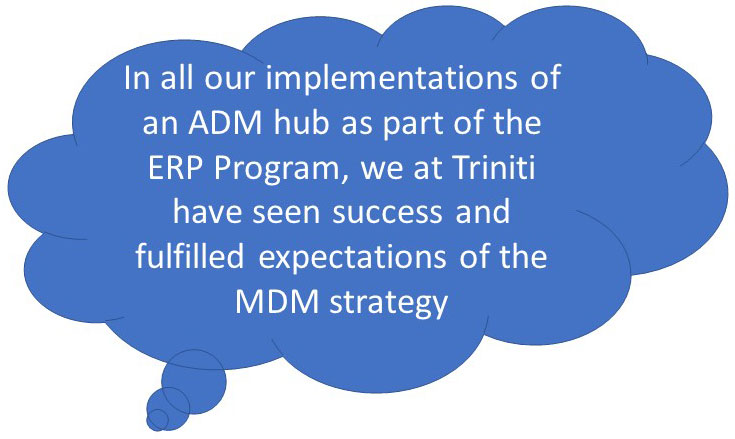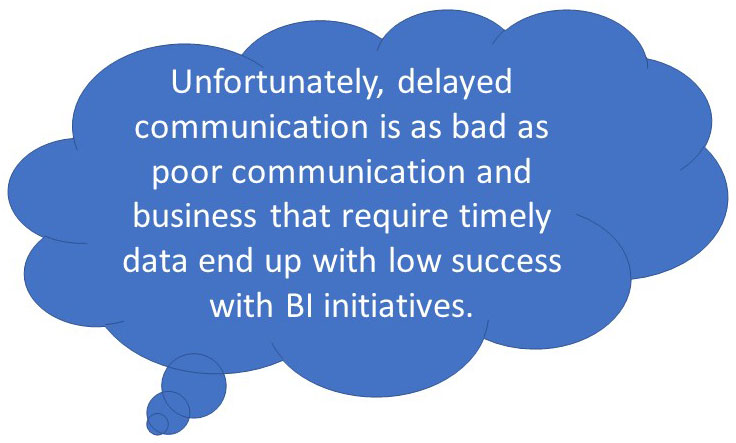 Executive Overview
Executive Overview
An ADM approach to MDM will yield the following results:
-
Elimination of transactional errors in applications such as ERP, CRM, HCM, and SCM
-
Timely, reliable, accurate, and complete information in Business Intelligence reports enables fact-based decision making
-
Low cost of implementing and sustaining the MDM program
-
Increased profitability
Using language as an analogy, we make the case.
Key Challenges
Executives who undertake Master Data Management (MDM) programs to improve data quality in transaction systems such as ERP and CRM are often disappointed with the outcomes. They still see latency in BI reports hindering data-driven decision making, errors in planning and execution resulting in rework, lost sales, poor forecasting, shipping errors, and fines.
Key Approaches
To gain full benefits of an MDM program, visionary organizations have realized that they must have one of the two following options:
-
Master data governed in a pure-play MDM tool integrated in real-time with the applications that consume master data
-
An Application Data Management (ADM) tool to augment an MDM tool or in place of it. If you are unfamiliar with ADM, then it is a tool that has MDM capabilities, with out-of-the-box real-time integration, with applications like ERP or CRM
While both options empower users to trust their data and spend their time on operations rather than fixing data, option #2 is more economical. MDM programs will deliver business value only when viewed from within the context of the applications that consume trusted master data. This white paper will illustrate why ADM tools with MDM features are better alternatives than pure-play MDM tools. The necessity to use both MDM concepts and ADM is explained in this paper using language as an analogy.
History
In the 1990s, as organizations started to roll out ERP, SCM, APS, and data warehousing applications, there was a need to define master data in each application. These definitions of master data such as products, customers, and suppliers are part of transactions and reports. Since there was no governance within the applications, master data quality prevented these applications utilized optimally. Additionally, there was no single source of truth for master data.
Misguided by experts and analysts, data stewards believed that organizations would benefit from having a single source of truth for master data in stand-alone MDM hubs. This master data then is leveraged across all other IT initiatives of the organization that depended on master data to run their day to day transactions and reports. They believed this to be the logical solution to the problems resulting from poor master data. Unfortunately, many MDM customer surveys reported less-than-stellar results from such MDM projects. Organizations continued to have quality and trust issues concerning master data usage in their applications. Most of these MDM hubs become silos themselves, serving only a small subset of the enterprise application data needs.
What is the explanation for this under-performance and disillusionment with MDM software? Wasn't MDM supposed to be the panacea for all master data problems? What caused the low ROI from these investments, despite starting with promising business cases?
Most importantly, what can you do differently to avoid failures with MDM initiatives or even ignore the sunk cost and pivot?
An inability to accurately articulate the actual contribution of a well-designed MDM program and its role in Enterprise Information Management lies at the root of missed expectations and disappointment. To meet expectations from MDM buying decisions, all it takes is a slight recalibration of the understanding of what a product/service can and should do. We will clarify this understanding using the language analogy.
Alphabets, Words, and Sentences
Language is a transformative power. The words we choose, the verbal expression of our ideas and feelings leave a powerful, lasting impression on both the speaker, the listener, the writer, and the reader.
However, merely knowing the alphabet or words is not enough. The language aims to help communicate higher-order thoughts, concepts, and ideas that lead to actions to pursue common objectives. You achieve them when you form sentences using the only afore-mentioned words to convey unambiguous messages to the audience.
Why use language as an analogy?
-
To clear a misconception regarding MDM
-
"Semantic," a key term used in MDM, as in semantic consistency, means "relating to meaning in language"
MDM Definition according to Gartner
"Master data management (MDM) is a technology-enabled discipline in which business and IT work together to ensure the uniformity, accuracy, stewardship, semantic consistency, and accountability of the enterprise's official shared master data assets. Master data is the consistent and uniform set of identifiers and extended attributes that describes the enterprise's core entities, including customers, prospects, citizens, suppliers, sites, hierarchies and chart of accounts".
In a nutshell, MDM systems allow the creation of a “business lingua franca.” It is:
A medium of corporate communication to be employed within and outside an enterprise, comprising a well-defined set of words and terms with precise meanings. It enables enterprise-wide communication amongst various business units and functions without any ambiguity and concerns regarding information quality.
MDM supplies the alphabets and words (master data is after all the nouns of the business) of this business language. Correctly implemented, the MDM system provides a single trusted source of correct business terms and meanings to be used within the various business processes executed by the Enterprise. MDM is the “Go to source” whenever there are conflicts about the structure or meaning of any business concept and its intended usage. It is the dictionary of the Enterprise – the definitive guide to truth.
MDM – Necessary but not Sufficient
Alphabets and words are the building blocks for communication. However, the user applies rules of meaning and grammar to frame the proper sentences to use words appropriately. The onus of using the building blocks appropriately and unambiguously communicating is with the speaker/writer. Having an MDM hub with data that does not integrate in real-time with 100% authorship is akin to having just the alphabet and necessary words. Figuratively speaking, users have to apply impeccable "grammar" for meaningful, unambiguous "sentences" from these words. Examples include:
-
Pick the precise part number
-
Select the precise supplier
-
Use the appropriate GL Account
Everyday transactions such as buying and selling goods to customers, producing finished goods and components, pricing products, finding vendors, charging customers for sales happen in applications such as ERP, CRM, SCM that consume Master Data. Hence, implementing an MDM tool alone to administer the MDM program will not solve the master data quality problem – it has to reflect in these consuming applications. Some scenarios in the business world that highlight this interrelationship of language and word are described below:
As discussed above, picking the correct part number, customer, or supplier has downstream implications.
- Rationalize the Product Portfolio
- Should I continue making this product available to customers or make it obsolete?
- Do I increase its price because its demand is high?
The item and the customer represent the "words," and the sentence analogy refers to the transactions, and BI or operational reports represent the understanding.
These are the practical challenges business executives face every day. So, who or what mechanism can provide the missing capability of composing meaningful sentences?

ADM and MDM – A Combined Approach
Application Data Management (ADM) tools are the solution to bridging this gap. A rough definition of ADM as per Gartner is “ADM hubs are those designed to manage semantic consistency of a wider range of data for a specific application or a suite of applications such that some local optimization is achieved”.

In all our implementations of an ADM hub as part of the ERP Program, we at Triniti have seen success and fulfilled the MDM strategy's expectations. Other organizations report similar outcomes.
ADM Hubs are where consumers of master data – application systems such as ERP, CRM, SCM, HCM, Data Warehouses – have to supply the proper transactional context. It enables downstream participants in the information processing supply chain to benefit from the sound data. Imagine these application systems (ERP, CRM, SCM, HCM, Data Warehouses) to be a word processing document editor. ADM provides the spelling and grammar check utility to these document editors so that readers of the document can consume the content unambiguously.
When the rubber meets the road, value addition in the real business takes place with error-free transactions. Thus, to gain real business benefits of rationalizing master data, executives must realize that the transactional and other downstream reporting/analytics systems should be architected to work seamlessly with the master data. Eliminate the need for someone or ETL to fix transaction errors. Ensure the "semantic" accuracy of master data so users do not make mistakes.
MDM (alphabets and words) has little value-generating operational and BI reports if they contain incorrect master data in application transactions. The clean transactions created through ADM represent clear communication in the language analogy. Miscommunication is the equivalent outcome without ADM. ETL tools mitigate this problem but introduce latency. Unfortunately, delayed communication is as bad as poor communication. They are the most expensive part of a BI initiative. With a pure-play MD solution, businesses that require timely data end up with low success with BI initiatives.
Power of Triniti’s ADM
Triniti's ADM solution with specific MDM features offers Excel-like simplicity and productivity. Still, with integrity checks and access control, users can easily and quickly build a high-quality data source. Triniti Global Product Maintenance (TgPM) is an example of a combined ADM and MDM solution. It provides ALL the foundational capabilities to support user-configured, workflow-based governance of shared master data. Rapidly deploy its data management framework and provide a single platform to manage all data domains (Product, Customer, Supplier, Location, GL Account).
Summary
Business and IT leaders must understand the need to rationalize their master data as a precursor to achieving ambitious business transformation. While evaluating candidate vendors and their solutions, they need to understand business requirements from all member applications for master data governance. Doing so would help them critically assess and understand MDM solutions' deciding technical capabilities and ADM's significance. It will enable them to make an informed decision regarding either choosing an MDM only partner or a partner that provides both MDM and ADM capabilities. Triniti customers have reaped the benefits of good data from using Trinti ADM. They continue to enjoy immense business benefits at a low cost of ownership!


